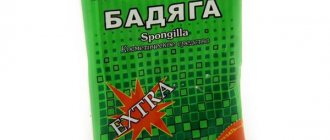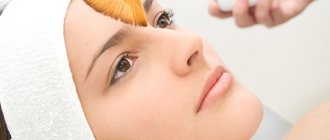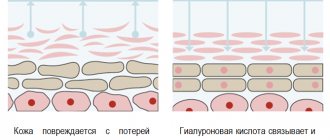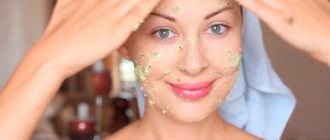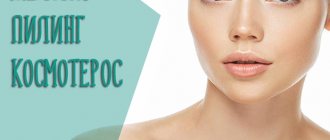What is ferul peeling
The cosmetic procedure belongs to the group of superficial chemical peels, since it affects only the top layer of skin. The cleansing effect is due to the removal of dead cells and the activation of metabolic processes.
What is ferulic acid
The basic ingredient of ferul peeling is the acid of the same name. It is of plant origin and is found in peanuts, apples, and oranges.
Ferulic acid has a mild cleansing effect and prevents the formation of thymol dimers, which at the DNA level are formed under the influence of ultraviolet rays and are associated with the production of melanin.
It is this disorder that causes dark circles under the eyes and age spots, and ferul peeling can eliminate these manifestations.
Mechanism of peeling effect on the skin
Ferulic acid has an antioxidant effect. This is possible due to the fact that there is an additional electron in the structure of the molecule, which helps the substance react with active oxygen and prevent oxidative processes.
In addition, the acid interacts with free radicals, which slows down the aging process.
Ferulic acid's ability to block the production of tyrosinase (an enzyme that accelerates melanin synthesis) helps in the fight against hyperpigmentation. Therefore, the substance is added to whitening creams and serums.
During peeling, the whitening effect is achieved by removing and renewing the surface layer of skin.
Ferulic acid in cosmetology
Ferulic acid is a plant antioxidant that is found mainly in the bran of cereal plants. Research and experience in using this component in cosmetology show that it provides a pronounced antioxidant, rejuvenating, brightening and sun protection effect. As an additional substance, it stabilizes other antioxidants in cosmetics, in particular, increasing the activity and bioavailability of vitamin E. It is also an active ingredient in dietary supplements.
Synonyms: Ferulic Acid, Trans-Ferulic acid, Natural Ferulic acid. Patented formulas: BioNatural® Ferulic Acid, Ageguard™ FA, EcoCare™ GO, Ferulan Active, Only IOF, Dermatein® Power Powder III - Anti-Aging.
Cereals are the main source of ferulic acid 32102
The effect of ferulic acid in cosmetics
Ferulic acid is one of the most powerful natural antioxidants. The name of this ingredient translated from ancient Greek means “the one that does not wither.” Indeed, ferulic acid protects not only plants, but also our skin from wilting. It is an antioxidant that can neutralize several different types of free radicals at once. It is a polyphenolic compound that has an anti-inflammatory effect and a moderate-intensity whitening effect (tyrosinase inhibitor). Ferulic acid is also used in cosmetics as a direct antioxidant and as a substance that absorbs ultraviolet waves (in combination with other physical or chemical filters). Some studies have demonstrated that exposure to ultraviolet light actually increases the antioxidant activity of ferulic acid. One study also found that ferulic acid is a more effective antioxidant than alpha-tocopherol (vitamin E), beta-carotene, and various ascorbic acid metabolites. Quite often it is used as an antimicrobial agent.
Ferulic acid has been shown to enhance the antioxidant activity of many other antioxidants in many studies. In particular, when present in cosmetics, the combination of tocopherol and ascorbic acid doubled the protective effect of these vitamins and helped prolong their effect. It is well known that vitamin C is a very problematic substance in skin care - it oxidizes and degrades too easily. In addition, several more factors need to be controlled for ascorbic acid to have an effect in the composition of a cosmetic product. Ferulic acid solves these problems by stabilizing vitamin C and preventing its oxidation. By the way, the combination of vitamins C and E with ferulic acid is a very popular complex in the cosmetic industry and is beneficial for the skin.
Who is ferulic acid indicated for?
- In order to prevent wrinkles and other signs of photo- and chronological aging.
- For exfoliation (in peelings and skin cleansing products).
- To prevent photodamage.
- To reduce pigmentation on the skin.
For whom is ferulic acid contraindicated?
Considered to be a safe component. When ferulic acid first appeared on the cosmetic market, it was only available in a form that required alcohol and solvents before it could be used externally. However, biotechnologists subsequently managed to improve the molecule and now this ingredient is included in cosmetics without unwanted solvents.
Cosmetics containing ferulic acid
Ferulic acid is included in day creams for the face, anti-aging series, moisturizing body lotions, protective serums and concentrates, sunscreen products, and after-sun products. It is also the main active ingredient of the popular ferul peeling. As a rule, the concentration of this ingredient in cosmetics ranges from 0.5 – 0.8%, in peeling – from 30% and above. A synthetic form of ferulic acid is used in antiperspirants.
Sources of Ferulic Acid
Ferulic acid is extracted through various extraction techniques primarily from rice bran. However, many other plants contain this phytocompound, which, by the way, plays a key role in the life of representatives of the kingdom of Flora. In particular, thanks to ferulic acid, the cell wall normally performs its barrier function, and the plant itself is reliably protected from pathogenic microorganisms and the scorching rays of the sun. Thus, ferulic acid is found in high concentrations in the cell walls of plants such as wheat, peanuts, coffee, amaranth, oranges and apples.
Ferulic acid derived from rice bran 31942
As a cosmetic substance, it is a yellowish (shades vary) powder with a characteristic odor, soluble in warm water and alcohols (the pH of the solution used to prepare the cosmetic ranges from 3.2 to 3.4). The fact is that for effective delivery of vitamin C to tissues, it is important to control several variables of ferulic acid: its pH must be acidic and below 3.5.
Many people interested in ferulic acid are often confused by the names of this ingredient on the label: trans-ferulic acid and natural (natural) ferulic acid. The fact is that both of these components are natural, and the difference in names only means how this acid is used - trans-ferulic acid is most often used in dietary supplements that people take as protection against aging, and natural - in cosmetics recipes.
Indications for ferul peeling
This type of exfoliation has a long-term effect, so it can be used not only to combat facial skin problems, but also to prevent them.
Indications for use:
- peeling will be useful for people with oily or porous skin;
- the presence of acne, acne and post-acne, rosacea.
Thanks to this cosmetic procedure, you can cleanse your face and slow down the aging process.
Ferulic peeling is recommended for women over 35 years old, when active age-related changes in the skin occur, in particular, expression wrinkles appear.
Indications for the procedure also include pigmentation, including melasma, rash, and photoaging.
Indications for use
The ferulic cleansing method is universal ; it is used to solve a wide variety of facial skin problems. A cosmetologist can recommend it in the following cases:
- the presence of a large layer of dead cells that block the access of oxygen and nutrients;
- frequent appearance of acne, acne and just single pimples;
- the first stage of the formation of facial wrinkles, when they are still weakly expressed;
- excessive oily or dry skin;
- the appearance of age-related or seasonal pigmentation;
- prevention of age-related changes and prevention of sagging skin.
Read about unusual and interesting types of peeling:
- fish cleansing;
- dry exfoliation for the face;
- color brushes;
- exfoliation with Hilak-Forte;
- coral peeling.
Stages of a facial procedure in the salon
Ferulic peeling is carried out in accordance with clear protocols, which consist of three stages:
- preparatory;
- main;
- care after the procedure.
Preparation
Before visiting a cosmetologist, you must use products based on fruit acids for 7-10 days. This applies to cleansing gels, tonics, and care creams. They will cleanse the skin so that peeling has the maximum effect, and also adapt it to the effects of acids, making the procedure more gentle.
Procedure protocol
The duration of the session usually does not exceed 30 minutes.
The cosmetologist first cleanses the face, treats it with degreasing lotion, and then lubricates sensitive areas such as the skin around the eyes and lips with a special cream.
Next, the skin is wiped with an oxygen spray made from thermal water.
And only after this, several layers of ferul peeling are applied at intervals of 2-3 minutes. During each such interval, the skin is treated with a special conditioner, which includes vitamin C.
The mixture must be kept on the skin for a certain time, which is calculated for each individual. The cosmetologist must monitor the condition of the upper layers of the skin. If any unpleasant sensations appear, for example, severe burning or itching, the mixture is removed.
At the end of the procedure, the peeling is washed off with water, and the face is covered first with a soothing mask and then with a moisturizer (if necessary, with sunscreen properties).
When cleaning with indelible peeling, you will need to treat the skin with a product containing 1% retinol, which should be washed off with water at home after 6-8 hours.
Price
The price of ferulic acid is quite high due to the difficulty of obtaining it, so this procedure costs a lot of money - on average at least 3 thousand rubles per session (price may vary depending on the level of the salon).
How often is peeling performed?
The main course of ferul peeling consists of 7 sessions at weekly intervals. The entire course can be repeated annually.
The effect of ferulic acid on the skin
- Thanks to ferulic acid, blood microcirculation is activated and wrinkles are smoothed out. The skin is moisturized and renewed from the inside. It is saturated with oxygen and begins to shine.
- Ferulic acid can reduce age spots and even get rid of them completely.
- Ferulic acid also has a beneficial effect on problem skin. Due to its anti-inflammatory, antimicrobial and soothing properties, products containing it are indicated for acne.
- It is important that it does not cause allergies and is gentle on sensitive, dry, thin skin.
- Among the properties of ferulic acid is the ability to protect against ultraviolet radiation. This natural UV filter protects against photoaging and premature wrinkles. Therefore, ferulic acid is an indispensable component of many sun protection products, pre- and post-tanning creams.
The best drugs
If desired, all-season ferul peeling can be done at home. Both ready-made formulations and self-made products are suitable for this.
Biomatrix
This is a peeling that contains 30% mandelic acid and 5% ferulic acid. It has a pronounced comedolytic effect, effective in the fight against blackheads and spider veins. In addition, Biomatrix peeling stimulates the synthesis of collagen and elastin, which are responsible for skin turgor, and eliminates fine wrinkles.
Interesting: What is almond peeling for the face?
Stella Marina
Chemical peeling with ferulic acid (12%). The composition is additionally enriched with AHA 44, rutin and glycyrrhizic acid. To provide a cooling effect, essential oils of spearmint and peppermint are added to the product. Stella Marina has a deep rejuvenating and anti-rosacea effect, evens out skin tone, optimizes metabolism in the deep layers of the epidermis.
New Peel
In addition to ferulic acid, this Spanish product contains other fruit acids, as well as retinol. Ferulic acid neutralizes free radicals, thereby slowing down the aging process of the skin, and retinol stimulates protein production, increases skin density and elasticity, and prevents photoaging.
Mediderma
The line contains three products with different percentages of ferulic acid, additives and pH levels. Two of them are designed for all-season peeling and are suitable for all skin types.
The classic composition contains 12% ferulic acid and 5% florentine (stops the transport of glucose into cells). Ferulac Plus contains 8% ferulic acid. Additional substances: retinol, lactic, malic and citric acids.
The last component enhances the effect of the drug and helps in the fight against various rashes.
The use of the product helps to cope with photo- and bioaging, hyperpigmentation, skin dullness, decreased turgor, acne and post-acne.
Dermatime
This drug contains 12% ferulic acid. There are no additional components other than alcohol and water, so this peeling does not cause allergic reactions. Nevertheless, it has an effective cleansing effect, prevents premature aging of the skin, making it smoother and more elastic.
Natinuel
This is a professional peeling based on mandelic and ferulic acids. It has an antioxidant, disinfecting, polishing and revitalizing effect. Improves skin condition and strengthens its protective function. Suitable for all types except hypersensitive. May be used before and after sun exposure.
Why ferulic acid is good for the skin
This antioxidant does not repair existing damage, but acts as a shield against free radicals. Ferulic acid actively prevents aging; here are just some of its beneficial properties:
- reduces the formation of fine wrinkles;
- prevents the skin from sagging, as it protects it from free radicals, which cause the skin to lose collagen;
- fights inflammation - antioxidants are widely known for their anti-inflammatory properties;
- reduces the formation of age spots and reduces the likelihood of melasma, a pigmentation disorder in which dark spots with clear boundaries appear on the face, neck and other parts of the body;
- evens out skin tone and protects it from redness;
- reduces dark spots from acne. If used regularly, the antioxidant's anti-inflammatory properties will minimize the damage that occurs due to acne;
- enhances the effect of vitamins C and E. In combination with other antioxidants, ferulic acid works even more effectively;
- restores skin after tanning and protects it from photoaging.
Features of carrying out at home
Modern cosmetic products with ferulic acid allow you to perform salon facial cleansing at home, which makes it possible to save money on visiting a cosmetologist. This became possible due to the fact that the drugs have a gentle effect on the skin and have almost no adverse reactions. You can purchase such products in pure form in ampoules and perform peeling with ferulic acid yourself.
With vitamin E
To perform peeling, you need to mix a vitamin E capsule, a 15% solution of ferulic acid and a 3% solution of alpha-lipoic acid. This composition allows you to strengthen the protective functions of the skin and at the same time have a cleansing and rejuvenating effect.
The product should be applied to previously cleansed and oil-free skin in several layers with a break of 1-3 minutes. It is recommended to use aloe gel for fixation. The peeling should be washed off after 6-12 hours, depending on the recommendations in the instructions for the cleansing composition.
With vitamin C
Vitamin C is involved in redox processes and increases protective functions. The product is applied in 2-4 layers depending on the condition of the skin.
Allow about 2-3 minutes between each coat to allow the product to absorb.
You need to wash off the peeling after 12 hours, for which warm water is suitable. After a few days, the skin may become covered with scales that cannot be removed on your own to avoid scarring. The crusts should fall off on their own.
With almond oil
Many companies produce almond-ferul peeling, but based on mandelic acid. At home, you can prepare an oil-based composition without exfoliating effect. To do this, you will need to prepare a mixture that consists of the following components:
- ferulic acid (12-15%);
- propylene glycol (15-18%);
- alpha lipoic acid (3%);
- oil and water (5%).
With retinol
This peeling will get rid of pronounced spider veins and swelling and tighten the skin. To prepare the product, you need to mix retinol ointment and ferulic acid (12-15%) in equal parts.
In this case, no preparation is required. You just need to remove your makeup and apply a dehydrator to dry your skin. After this, you can begin applying peeling using a cotton swab.
This must be done in several stages with an interval of 3 minutes between each of them. The last layer should be retinol. Next, the peeling needs to be secured with aloe gel.
It is necessary to wash off the drug with warm water after 12 hours. Two days after this, peeling will begin, which should go away on its own. Peeled films cannot be removed, otherwise there is a risk of scarring. You can speed up the skin cleansing process with moisturizers.
General rules for peeling at home
Before deciding to carry out the procedure at home, you need to study and strictly follow the procedure. When making your own peeling, special preparation using products with acids and a neutralizer is not required.
If you have chosen a professional composition, then you should strictly follow the salon protocol and follow all recommendations.
Additionally, you will need to purchase indicator strips to measure the acidity of the product. In this case, it should be at a pH level of 3-4.
How is ferul peeling performed?
This type of peeling can be performed on any skin type . Unlike other procedures, this manipulation is possible even in the summer. Even sensitive skin tolerates such peeling very favorably.
To begin with, the face is cleansed with a special lotion. Remove all contaminants. Including the remains of decorative cosmetics. Then the skin is degreased.
The procedure is absolutely painless, so no anesthesia is required.
Now the doctor begins the peeling itself. The special MediDerma product is applied in several layers with a cotton swab. A bright yellow mask forms on the face. The cosmetologist actively rubs the product. Within 15 minutes, the color of the drug fades and becomes almost invisible. At this stage you can go home. After 12 hours, the product should be washed off independently at home.
The next day your skin looks amazing. It becomes elastic, velvety, and acquires a healthy shade. After 3–4 days, active detachment of the epidermis , and the skin begins to peel off. At this time, the face requires special care. The skin should be constantly lubricated with hyaluronic acid-based moisturizers.
For a more effective result, you need to conduct at least 5 sessions. It is advisable to repeat the course of procedures annually.
Ferulic peeling has no side effects. Very rarely, after it is carried out, redness, a burning sensation, and any unpleasant manifestations occur on the skin. This most likely indicates individual intolerance to the components included in the drug.
This procedure can be carried out at home , but it is still best to trust in the hands of specialists.
Contraindications to ferul peeling
Like any other cosmetic procedure, this also has a number of contraindications in which this peeling is prohibited.
- Allergy to the components of MediDerma for ferul peeling.
- Skin wounds.
- Herpes in its acute stage of manifestation.
- Pregnancy and breastfeeding period.
- Chronic diseases in the process of relapse.
- Infectious diseases.
- Increased body temperature.
Healing period
Despite the fact that this is a gentle peeling, it still has a chemical effect, as a result of which the skin is damaged, which means it requires rehabilitation. The duration of the healing period is individual for everyone.
Prohibitions during rehabilitation
On the first day after the procedure, you must completely avoid contact with water. In addition, it is not recommended to touch your face with your hands, as there is a high risk of infection. For the same reason, it is strictly forbidden to remove crusts that have appeared (dead epithelial cells).
For 4-7 days it is not recommended to use decorative cosmetics, use scrubs or gommage for cleansing. There are also longer bans, for example, on visiting a solarium, bathhouse, or swimming pool (for several weeks).
Will there be peeling?
2-3 days after the procedure, slight peeling may appear, which quickly disappears. But its absence does not mean peeling is ineffective.
Skin care after peeling
To speed up recovery, it is recommended to use moisturizers that can strengthen the protective functions of the skin. These include creams with antioxidants, but they can only be used on the fourth day after the procedure. Additionally, the use of sunscreen may be required, especially in summer.
Side effects and complications
Ferulic facial cleansing can cause an allergic reaction, which manifests itself in the form of swelling and rashes. To avoid this, it is recommended to test the products on an inconspicuous and sensitive area, such as the crook of your elbow or wrist.
To do this, you need to apply a small amount of the product, and after a day evaluate the result: if there is no redness or irritation, then the composition can be used.
In rare cases, the following may sometimes appear: peeling, redness, swelling, and a feeling of tightness. Within 2-4 days, all these symptoms disappear on their own. If this does not happen, it is recommended to visit a dermatologist.


